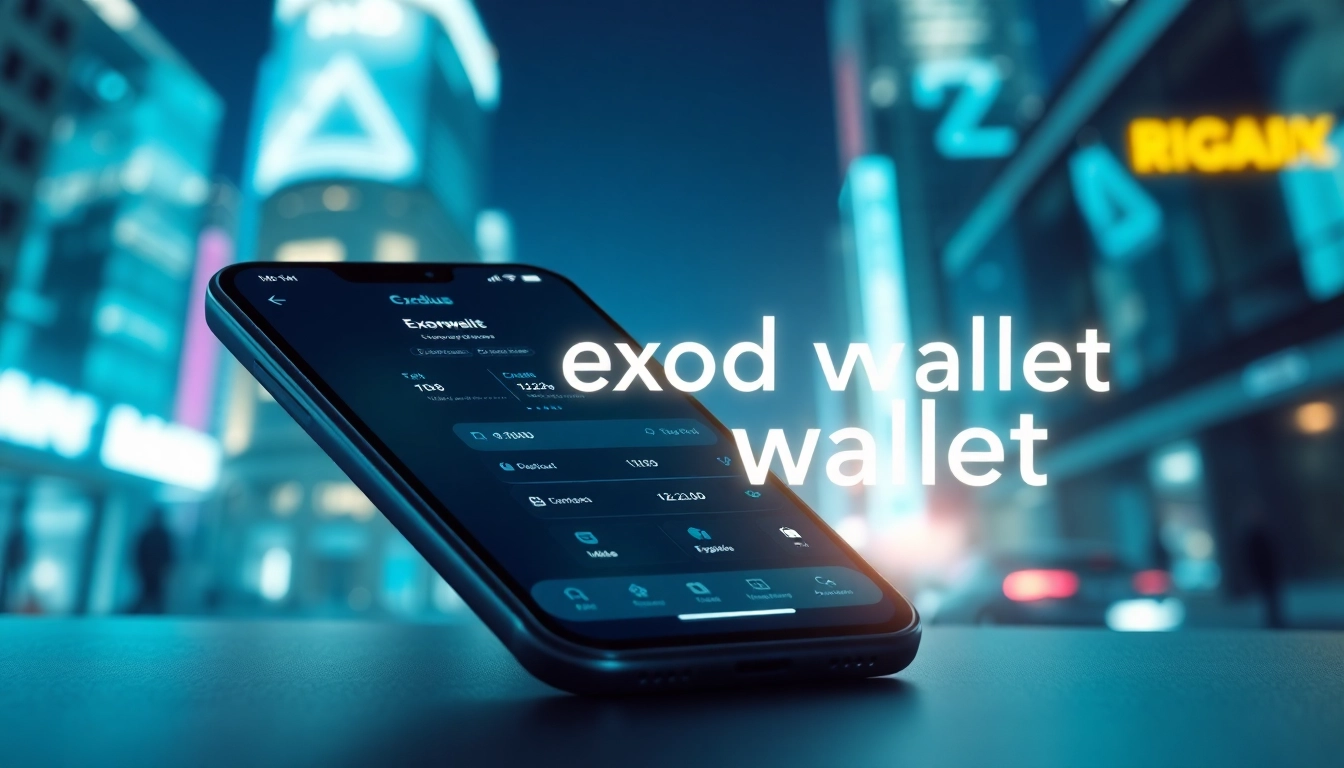Understanding the Exodus Wallet Basics
The exodus wallet is a popular choice among cryptocurrency enthusiasts for managing digital assets due to its user-friendly interface and multi-currency support. This section will explore the essentials of the Exodus wallet, covering its definition, key features, and the benefits it offers to both new and experienced users.
What is the Exodus Wallet?
Exodus Wallet is a software-based cryptocurrency wallet that enables users to securely store, send, receive, and exchange numerous cryptocurrencies and digital assets. Launched in 2015, Exodus caters to a diverse audience, from novices dipping their toes into the world of crypto to seasoned investors who require advanced features and functionalities. Unlike traditional cryptocurrency exchanges, Exodus acts as a non-custodial wallet, meaning users maintain control of their private keys and thus are solely responsible for their digital assets’ safety.
Key Features and Benefits of Exodus Wallet
One of the main attractions of the Exodus wallet lies in its array of robust features:
- User-Friendly Interface: The wallet’s intuitive design allows for seamless navigation, making it accessible for users of all skill levels.
- Multi-Currency Support: Exodus supports over 100 cryptocurrencies, providing users with the flexibility to manage a diverse portfolio.
- Integrated Exchange: The wallet features an in-built exchange, enabling users to swap various cryptocurrencies effortlessly without needing to leave the app.
- Security Measures: Exodus employs multiple layers of security, including the ability to set up a password and backup recovery phrases to protect user assets.
- Portfolio Tracking: Users can monitor their asset portfolio’s performance with the wallet’s built-in tracking functionality, demonstrating investment growth over time.
How to Get Started with Exodus Wallet
Getting started with Exodus is simple and can be completed in just a few steps:
- Download the Wallet: Visit the official Exodus website or the app store on your device to download the program.
- Install the Wallet: Follow the installation instructions provided.
- Create Your Wallet: Upon first launch, you will be prompted to create a new wallet and generate a backup phrase for recovery.
- Start Using Your Wallet: Fund your wallet by receiving cryptocurrencies or purchasing directly within the app.
Setting Up Your Exodus Wallet
Creating Your Exodus Wallet Account
To establish your Exodus Wallet, users must create an account securely:
After downloading, open the application, and choose the option to create a new wallet. The setup process includes establishing a secure password. This password will be critical for accessing the wallet on the device. Make sure to choose a strong and unique password to enhance security. Following this, Exodus will generate a recovery phrase—typically consisting of 12 or 24 words—that must be securely stored offline. This recovery phrase is essential in the event you need to restore your wallet on another device or if your device is lost.
Security Settings in Exodus Wallet
Security is paramount in the cryptocurrency realm, and Exodus offers several settings to safeguard your wallet:
- Password Protection: Setting a complex password helps deter unauthorized access.
- Backup Recovery Phrase: As mentioned, safeguarding your recovery phrase is critical. Ensure this is stored in a secure location, separate from your device.
- Two-Factor Authentication (2FA): While Exodus does not offer 2FA, using a secure device and creating strong, unique passwords can act as an alternative layer of security.
How to Recover Your Exodus Wallet
In case you encounter issues accessing your wallet, knowing how to recover it is vital:
- Download and install the Exodus app on your device.
- Choose the option to restore your wallet.
- Enter your recovery phrase when prompted.
- Set a new password to secure your wallet.
Following these steps will restore your wallet along with all of its assets, provided you have your recovery phrase safe.
Using the Exodus Wallet Effectively
Buying and Selling Cryptocurrencies with Exodus Wallet
Buying and selling cryptocurrencies within the Exodus wallet is straightforward. Users can purchase cryptocurrencies using a debit card or bank transfer by integrating partner services like Sardine. Here’s how to conduct these transactions:
- Navigate to the ‘Buy’ Option: Within the app, select the ‘Buy’ tab.
- Select Currency: Choose the desired cryptocurrency to purchase.
- Follow the Prompts: Input your payment details and confirm the transaction.
- Swap Cryptocurrencies: For selling or exchanging, simply access the ‘Exchange’ tab, choose the currencies to swap, and follow through to complete the transaction.
Managing Multiple Cryptocurrencies
Exodus simplifies the management of multiple cryptocurrencies within a single wallet:
The interface allows you to add various digital assets seamlessly. Users can track their portfolio and asset allocation across different currencies by selecting wallets from the main dashboard. Additionally, users can customize their settings for each asset, allowing personal transaction limits and notifications, enabling more organized management of their investments.
Using Exodus Wallet for Web3 Applications
As decentralized applications (dApps) gain popularity, Exodus wallet serves as a bridge to the Web3 ecosystem. Users can connect their Exodus wallet to various dApps for yield farming, NFT purchases, and more:
To utilize Web3 features, users have to integrate their wallet with browser extensions or dApp platforms that support wallet connections. This allows for interactions within the decentralized finance (DeFi) space, facilitating access to a wide range of applications from lending to staking and even NFT marketplaces.
Advanced Features of Exodus Wallet
Integrating Hardware Wallets with Exodus
For those prioritizing security, Exodus offers compatibility with Trezor hardware wallets, allowing for seamless integration:
This integration means you can manage your hardware wallet assets through the Exodus interface while keeping them in cold storage. To connect a hardware wallet:
- Open the Exodus wallet application.
- Navigate to the ‘Settings’ and select ‘Trezor’ integration.
- Follow the prompts to connect your Trezor device, allowing you to interact with your crypto through Exodus.
Passive Income Opportunities within Exodus Wallet
Exodus wallet provides opportunities for users to earn passive income directly from their assets:
Through staking and earning features, users can lock up certain cryptocurrencies, which accrue rewards over time. For example:
- Tezos (XTZ): Users can stake Tezos through Exodus to earn rewards periodically, typically every three days.
- Cosmos (ATOM): Similarly, Cosmos can be staked for rewards on a dynamic basis, allowing users to benefit from network participation.
This highlights how Exodus can not only be a storage solution but also a tool for enhancing investment revenue.
Optimizing Fees When Using Exodus Wallet
Understanding and managing the fees associated with using Exodus is vital for maximizing returns:
While Exodus doesn’t impose withdrawal fees, it does have ‘baked-in’ spread fees on crypto exchanges and purchases. Users looking to minimize these costs can do the following:
- Monitor Network Fees: Pay attention to network congestion, as fees vary throughout the day.
- Choose Optimal Times for Transactions: Execute transactions during lower traffic periods to reduce overall fees.
- Assess Swap Rates: Check comparative swap rates before engaging in transactions, ensuring you’re getting the best deal.
Troubleshooting and Support for Exodus Wallet
Common Issues with Exodus Wallet and Solutions
Users may encounter various issues while using the Exodus wallet. Understanding these common problems and their solutions can mitigate frustrations:
- Transaction Delays: Closing the app and re-opening can refresh the network connection, speeding up pending transactions.
- Cannot Access Wallet: Ensure that your device’s internet connection is active. If issues persist, restoring from the recovery phrase may be necessary.
Resources for Exodus Wallet Users
Exodus users have access to a variety of resources for support, including:
- Official Exodus Knowledge Base: A comprehensive source for troubleshooting advice and guides.
- Community Forums: Engage with other users to share experiences and solutions to common problems.
When to Contact Exodus Wallet Support
If users face significant issues that self-service resources do not resolve, contacting Exodus support is recommended. Users should reach out when:
- Transactions are unresponsive beyond typical delays.
- Concerns arise regarding the security of the wallet.
- Questions emerge about account recovery procedures or technical malfunctions.

